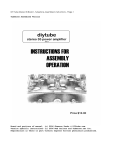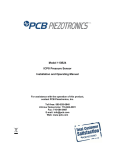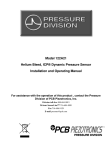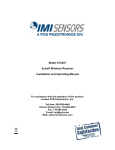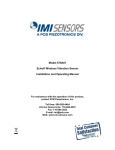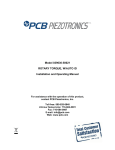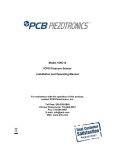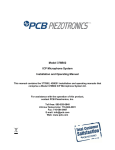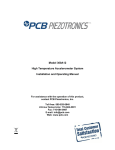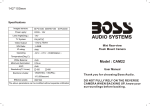Download Model 112A05 Charge Output Pressure Sensor Installation and
Transcript
Model 112A05 Charge Output Pressure Sensor Installation and Operating Manual For assistance with the operation of this product, contact PCB Piezotronics, Inc. Toll-free: 800-828-8840 24-hour SensorLine: 716-684-0001 Fax: 716-684-0987 E-mail: [email protected] Web: www.pcb.com Warranty, Service, Repair, and Return Policies and Instructions The information contained in this document supersedes all similar information that may be found elsewhere in this manual. Total Customer Satisfaction – PCB Piezotronics guarantees Total Customer Satisfaction. If, at any time, for any reason, you are not completely satisfied with any PCB product, PCB will repair, replace, or exchange it at no charge. You may also choose to have your purchase price refunded in lieu of the repair, replacement, or exchange of the product. Service – Due to the sophisticated nature of the sensors and associated instrumentation provided by PCB Piezotronics, user servicing or repair is not recommended and, if attempted, may void the factory warranty. Routine maintenance, such as the cleaning of electrical connectors, housings, and mounting surfaces with solutions and techniques that will not harm the physical material of construction, is acceptable. Caution should be observed to insure that liquids are not permitted to migrate into devices that are not hermetically sealed. Such devices should only be wiped with a dampened cloth and never submerged or have liquids poured upon them. Repair – In the event that equipment becomes damaged or ceases to operate, arrangements should be made to return the equipment to PCB Piezotronics for repair. User servicing or repair is not recommended and, if attempted, may void the factory warranty. Calibration – Routine calibration of sensors and associated instrumentation is recommended as this helps build confidence in measurement accuracy and acquired data. Equipment calibration cycles are typically established by the users own quality regimen. When in doubt about a calibration cycle, a good “rule of thumb” is to recalibrate on an annual basis. It is also good practice to recalibrate after exposure to any severe temperature extreme, shock, load, or other environmental influence, or prior to any critical test. PCB Piezotronics maintains an ISO9001 certified metrology laboratory and offers calibration services, which are accredited by A2LA to ISO/IEC 17025, with full traceablility to N.I.S.T. In addition to the normally supplied calibration, special testing is also available, such as: sensitivity at elevated or cryogenic temperatures, phase response, extended high or low frequency response, extended range, leak testing, hydrostatic pressure testing, and others. For information on standard recalibration services or special testing, contact your local PCB Piezotronics distributor, sales representative, or factory customer service representative. Returning Equipment – Following these procedures will insure that your returned materials are handled in the most expedient manner. Before returning any equipment to PCB Piezotronics, contact your local distributor, sales representative, or factory customer service representative to obtain a Return Materials Authorization (RMA) Number. This RMA number should be clearly marked on the outside of all package(s) and on the packing list(s) accompanying the shipment. A detailed account of the nature of the problem(s) being experienced with the equipment should also be included inside the package(s) containing any returned materials. PCB for a complete statement of our warranty. Expendable items, such as batteries and mounting hardware, are not covered by warranty. Mechanical damage to equipment due to improper use is not covered by warranty. Electronic circuitry failure caused by the introduction of unregulated or improper excitation power or electrostatic discharge is not covered by warranty. A Purchase Order, included with the returned materials, will expedite the turn-around of serviced equipment. It is recommended to include authorization on the Purchase Order for PCB to proceed with any repairs, as long as they do not exceed 50% of the replacement cost of the returned item(s). PCB will provide a price quotation or replacement recommendation for any item whose repair costs would exceed 50% of replacement cost, or any item that is not economically feasible to repair. For routine calibration services, the Purchase Order should include authorization to proceed and return at current pricing, which can be obtained from a factory customer service representative. Contact Information – International customers should direct all inquiries to their local distributor or sales office. A complete list of distributors and offices can be found at www.pcb.com. Customers within the United States may contact their local sales representative or a factory customer service representative. A complete list of sales representatives can be found at www.pcb.com. Toll-free telephone numbers for a factory customer service representative, in the division responsible for this product, can be found on the title page at the front of this manual. Our ship to address and general contact numbers are: Warranty – All equipment and repair services provided by PCB Piezotronics, Inc. are covered by a limited warranty against defective material and workmanship for a period of one year from date of original purchase. Contact DOCUMENT NUMBER: 21354 DOCUMENT REVISION: B ECN: 17900 PCB Piezotronics, Inc. 3425 Walden Ave. Depew, NY 14043 USA Toll-free: (800) 828-8840 24-hour SensorLineSM: (716) 684-0001 Website: www.pcb.com E-mail: [email protected] PIEZOELECTRIC CHARGE MODE PRESSURE SENSOR GENERAL OPERATION MANUAL 1.0 INTRODUCTION Quartz charge mode pressure sensors offer high performance for precise pressure measurements over a wide range of near-static and dynamic pressures. The sensors use the piezoelectric properties of quartz to convert an applied pressure into an analogous electrical charge. The internal design of a sensor incorporates a quartz sensing element that provides high sensitivity over a wide range of pressures. As pressure is applied to the diaphragm of the sensor, a charge is generated in the quartz crystals. The high-impedance electrostatic charge is then conditioned externally by either a laboratorystyle charge amplifier or in-line charge converter prior to being sent to a readout or recording device. 2.0 2.1 1 DESCRIPTION Series 111A General Purpose Miniature Sensor The Series 111A General Purpose Miniature Sensor is a high-precision, charge mode pressure sensor used for dynamic measurement of compression, combustion, explosion, pulsation, cavitation, blast, pneumatic, hydraulic, fluid and other similar types of dynamic pressure. The series consists of the Models 111A, 111A02, and 111A03 (along with special versions), having pressure ranges of 3 000, 100, and 10 000 psi (20684, 689, and 68947 kPa), respectively. See Figure 2.1. Charge mode sensors are ideally suited for applications where wide dynamic range, high frequency response, and/or high shock phenomena are a consideration. Such applications include compressors, engines, blast, ballistic, pneumatic, hydraulic, and fluid pressures. Enclosed is a Specification Sheet that lists the complete performance characteristics of the sensor purchased. In addition to the standard features offered with the sensor, a variety of options are also available on some sensor models. When listed before the model number, the following prefix letters indicate that the sensor is supplied with optional features: A option E option H option J option M option P option V option W option Ablative thermal barrier Emralon coating Hermetic seal Electrical isolation (mounting adaptor required) Metric thread Positive polarity output (for use with non-inverting amplifiers) Special attached cable (length/type) Waterproof cable connection Other prefix letters, such as K, KR, GK, GKR, KL and GKL indicate that the sensor is ordered in kit form, which includes cabling, power supplies and accessory mounting hardware. See the enclosed Prefix Sheet for additional details. Drawing Number: 21067 Revision: A This rugged instrument measures transient or repetitive phenomena, relative to the initial or average level, over a wide amplitude and frequency range. It comfortably tolerates adverse environmental conditions. The sensor follows transient events up to a few percent of the system time constant, which, depending on the system, may be sufficient for static calibration by conventional methods. The sensor’s internal design consists of a rigid, multi-plate, compression mode quartz element. PIEZOELECTRIC CHARGE MODE PRESSURE SENSOR GENERAL OPERATION MANUAL 2.2 Series 112A High Sensitivity Miniature Sensor The Series 112A High Sensitivity Miniature Sensor is a high-precision charge mode pressure sensor designed for higher charge sensitivities necessary when measuring compression, combustion, explosion, pulsation, actuation, cavitation, fluid, blast, turbulence and sound pressures. The series consists of the Models 112A, 112A02, and 112A03 (along with special versions), with pressure ranges of 3 000, 100, and 10 000 psi (20684, 689, and 68947 kPa), respectively. See Figure 2.1. This quartz sensor measures near-static and dynamic pressures from full vacuum to 3 000 psi (15 000 psi optional). It measures transient or repetitive phenomena, relative to the initial or average pressure level, over wide amplitude and frequency ranges and under the most adverse environmental conditions. System voltage sensitivities range from 0.01 mV/psi to 1.0 volt/psi, depending on the charge amplifier involved. The Series 112A High Sensitivity Sensor contains a rigid multi-plate sensing element with an integral compensating accelerometer to minimize vibration sensitivity. It is housed in all-welded stainless steel. 2.3 Models 112A04 and 112A05 High Temperature Miniature Sensor The Model 112A04/112A05 High Temperature Miniature Sensor is a high-precision, charge mode pressure sensor designed specifically for use in compressors, engines, turbines, heat exchanger combustion chambers and bombs, at moderate and high temperatures. The Models 112A04 and 112A05 operate to a maximum temperature of 600°F ( 315°C). See Figure 2.1. The all-welded, hermetic stainless steel construction of this sensor ensures reliable operation in hightemperature environments. It is constructed with a rigid, multi-plate sensing element and integral compensating accelerometer to minimize vibration sensitivity. Drawing Number: 21067 Revision: A 2.4 2 Series 113A High Frequency Miniature Sensor The Series 113A High Frequency Miniature Sensor is a charge mode pressure sensor designed to measure shock wave, blast, explosion, ultrasonic and dynamic combustion pressures requiring ultra-fast response times. The Series 113A consists of the Models 113A, 113A02, and 113A03, having pressure ranges of 3 000, 100, and 15 000 psi (20684, 689, and 103420 kPa), respectively. All are acceleration compensated. See Figure 2.1. This sensor measures transient or repetitive phenomena relative to the initial or average pressure level, over wide amplitude and frequency ranges and under the most adverse environmental conditions. This stainless steel instrument contains an extremely rigid compression-mode quartz element with an integral compensating accelerometer to reduce vibration sensitivity and partially suppress internal resonance effects. This results in an accurate, dynamic highfrequency response from the sensor. 2.5 Series 116 High Sensitivity Sensor The Series 116 High Sensitivity Sensor is a specialpurpose high temperature charge mode pressure sensor designed specifically to measure low-level pressures in severe environments. The unit is most frequently used in engines, hydraulic and pneumatic devices, compressors and turbines. Ideal for sound pressure measurements, microphones and small pressure agitations, its maximum dynamic pressure range is 100 psi (689 kPa). It is acceleration compensated to minimize vibration sensitivity and is capable of a fivemicrosecond rise time. See Figure 2.2. This sensor measures transient or repetitive phenomena relative to the initial or average pressure level, over a wide amplitude range and a usable frequency range near DC to between 20 000 and 30 000 Hz; the resonant frequency is 60 000 Hz, except for the Model 116A, which has a resonant frequency of 130 kHz. The Model 116 is extremely sensitive, with a nominal pressure response of 10 pC/psi. The operating temperature for the Series 116A ranges from -400°F to 400°F (-240°C to 204°C). The operating temperature for the Series 116B and 116C ranges from -400°F to 650°F (-240°C to 343°C). PIEZOELECTRIC CHARGE MODE PRESSURE SENSOR GENERAL OPERATION MANUAL 3 This hermetically sealed stainless steel sensor contains extremely rigid compression-mode quartz crystals with an integral acceleration compensating crystal to reduce vibration sensitivity and partially suppress internal resonance effects. 3.0 3.1 2.6 Series 171 High Sensitivity Sensor The Series 171 High Sensitivity Sensor is a specialpurpose high temperature charge mode pressure sensor designed specifically to measure low-level pressures in severe environments. The unit is most frequently used in acoustic devices, compressors and turbines. Ideal for sound pressure measurements, microphones and small pressure agitations, its maximum dynamic pressure range is 600 psi (4136 kPa). See Figure 2.3. This sensor measures transient or repetitive phenomena relative to the initial or average pressure level, over a wide amplitude range and a usable frequency range near DC to between 5 000 and 10 000 Hz; the resonant frequency is 25 000 Hz. The Model 171 is extremely sensitive, with a nominal pressure response of 1100 pC/psi. The operating temperature for the Series 171 ranges from 0°F to 500°F (-18°C to 260°C). Drawing Number: 21067 Revision: A INSTALLATION Overview When choosing an installation method, the advantages and disadvantages of each method must be carefully weighed. Characteristics like location, ruggedness, amplitude range, accessibility, temperature and portability may be greatly affected by the installation configuration and technique. Often, the most important and overlooked consideration is the affect the mounting technique has on the frequency of the pressure being measured by the sensor. Two basic mounting techniques are recommended for pressure sensors: the recess mount and the flush mount. The technique used is determined by the specifics of the individual application. See the Installation Drawing in this manual for additional details on the individual sensor series. PIEZOELECTRIC CHARGE MODE PRESSURE SENSOR GENERAL OPERATION MANUAL Passage length (inches) Passage resonance (kHz) Approx. fastest pulse rise time (microseconds) .050 .100 .200 .50 1.0 66 33 16.5 6.6 3.3 5 10 20 50 100 3.2 Fr = 4 3300 L Where: L = passage length (inches) The natural frequency and approximately fastest pressure step rise time for various length passages are shown in the following chart, using a medium of air at 77°F (25°C). Recess Mount Selected Values for 77°F (25°C) A recess mount protects the sensor diaphragm from the effect of high flash temperature and particle impingement. This method is often selected because it can prolong sensor life and increase data integrity by reducing thermal effects. See Figure 3.1. Measured resonant frequencies may differ slightly from the chart values due to variations in the velocity of sound in the air from changes in temperature and pressure of the air in the passage. To ensure diaphragm integrity, maintain .006 inches (.153 mm) of clearance ahead of the diaphragm using seal sleeve Model 065A05, shown in Figure 3.1. 3.3 Flush Mount In a flush mount installation, there is no reduced area passage from the sensor diaphragm to the test chamber. Instead, the sensor diaphragm is mounted flush with, or slightly recessed from, the inside surface of the test chamber. See Figure 3.2. When using a recess mount, note that the length of the passage may limit the frequency range of the measurement. The effect the passage has is similar to that of an under-damped second order system, with the resonant frequency determined by passage length. The passage length thus limits pressure pulse rise time and may also cause passage ringing. The function is described by the following equation: Fr = Where: Fr = V = L = V 4L resonant frequency passage (Hz) velocity of sound in air (feet/second) length of column (feet) For air at room temperature, the equation becomes: Drawing Number: 21067 Revision: A PIEZOELECTRIC CHARGE MODE PRESSURE SENSOR GENERAL OPERATION MANUAL If thermal transients or diaphragm impingement are concerns, use the flush mount technique only when space or frequency response considerations preclude the use of the recess mount installation. In severe or pyrotechnic environments, sensor life may be seriously curtailed when using this mounting method. 3.4 Flash Thermal Protection Several additional steps may be taken to provide protection from flash thermal effects. The sensor diaphragm may be thermally insulated at the factory, using a thin (.010 inches / 0.254 mm) coating of ablative silicone rubber, G.E. type 580 (“A” option). Before the insulation is applied, the surface of the diaphragm is treated with SS4004 primer. 3.6 5 Cabling Care and attention to cable attachment is essential, as the reliability and accuracy of your system is no better than that of the output cable. First, check that you have ordered the correct cable type. As with sensors, no cable can satisfy all applications. Special low-noise cabling should be used (e.g., PCB Series 003) with highimpedance, charge output devices. Connect the cable to the pressure sensor. A small amount of thread locking compound placed on the connector prior to attachment helps secure the cable during testing. For additional protection in harsh environments, the connection may be sealed with protective materials, such as silicon rubber, O-rings and flexible heat-shrink tubing (optional). If more protection is required, the recess mount may be filled with DC-4 silicone grease or its equivalent. In place of the silicone rubber, one or more layers of black vinyl electrical tape on the diaphragm may provide sufficient insulation. 3.5 Miscellaneous Installation Notes Thread adaptors, such as the Series #61, 3/8-24 or Series #62, 1/8 NPT, provide quick installation where mounting port diameter is not limited. Other adaptors include Series #63 Needle Probe, and Series #64 WaterCooled. Adaptor use simplifies mounting procedures and improves troubleshooting by reducing the incorrect data that can result from improper mounting. See the PCB General Catalog for details. A floating clamp nut, Model 060A03 (Model 060A05 for metric), 1/4 hex, facilitates mounting and removal of the sensor by clamping the sensor in place without placing undue stress on the quartz element. The clamp nut is provided with either standard (5/16-24) or metric (M7 x 0.75) threads and is supplied along with three seal rings. Model 008A Hardline Cable is recommended for operating temperatures above 500°F. This cable is supplied in lengths up to 40 feet (12,19 m). Drawing Number: 21067 Revision: A Plug the male connector on the cable into the mating female connector on the sensor. Then, holding the sensor stationary, secure the connector in place by tightening down the attached cable sleeve. See Figure 3.3. Route the cable to a charge amplifier or in-line charge converter, making certain to strain relieve the sensor/cable connection and minimize motion by clamping the cable at regular intervals. Common sense must be used to avoid physical damage and minimize electrical noise. Avoid routing cables near high voltage wires. Do not route cables along floors or walkways where they may be stepped on or become contaminated. Shielded cable should have the shield grounded at one end only. To dissipate any charge that may have accumulated in the cable, short the signal to ground prior to attachment to the charge amplifier or charge converter. PIEZOELECTRIC CHARGE MODE PRESSURE SENSOR GENERAL OPERATION MANUAL 4.0 6 CALIBRATION These sensors may be calibrated using static hydraulic techniques, such as dead-weight testers, or by comparison with a reference gage. When calibrating with a laboratory-style charge amplifier, set the charge amplifier to LONG, for the time constant setting, and allow the sensor to stabilize before applying pressure. If slow drift is apparent, apply the pressure to the desired level, and immediately take a reading. Release the pressure and take another reading at zero pressure to obtain the difference between the readings at the desired present level and zero pressure. If the drift is too fast to take a reading, clean the cable connections according to the procedures out-lined in Section 7.0, Maintenance. NOTE: Do not attempt to use a charge amplifier which, in the long time constant position, has less than a 5 000second time constant for quasi-static calibration of charge sensors. Any drift may cause error. Several charge amplifiers are designed especially for use with ceramic sensors, for higher low-frequency measurements. In general, these types are unsuitable for calibration of quartz pressure sensors by quasi-static means. A factory-supplied, NIST-traceable calibration graph is provided with each sensor, certifying its charge sensitivity in pC/psi, or when used with an in-line voltage amplifier, in mV/psi. 5.0 NORMAL OPERATION The high impedance signal generated by a charge output sensor is usually conditioned with a laboratory-style charge amplifier, such as the PCB Model 462A. The charge amplifier converts the high-impedance charge signal generated by the sensor into a low-impedance voltage signal. This signal may then be transmitted to a readout or recording device for analysis. See Figure 5.1 for a drawing of a typical system connection. NOTE: When using charge-amplified systems, the noise floor of the system is dependent on the input capacitance to the charge amplifier. To minimize noise, keep the cable length between the pressure sensor and the charge amplifier to a minimum. Cable length does not affect the system sensitivity. Drawing Number: 21067 Revision: A Before connecting the low-noise cable from the pressure sensor to the charge amplifier, be certain to ground the charge amplifier. This ensures that any excessive accumulated static charges across the sensor/cable combination are harmlessly discharged. If this precaution is not observed, the input FET of certain amplifiers may be destroyed. Press the ground button of the charge amplifier and adjust electrical zero if necessary. Once system components are connected, wait a few minutes for the system to thermally stabilize. Place the switch in the OPR (operate) position and proceed with the measurement. Refer to the charge amplifier operating manual for further operating details. For fixed sensitivity in-line charge amplifiers, such as the PCB Series 422, the system sensitivity (mV/psi) is determined as the product of the charge amplifier sensitivity (mV/pC) and the sensor sensitivity (pC/psi). With in-line voltage amplifiers, the system sensitivity is a function of the sensor, cable, and the in-line voltage amplifier. 5.1 Polarity When subjected to increasing pressure, these pressure sensors have a standard negative-going charge output. Because most charge amplifiers are signal-inverting, the resultant signal is positive-going. Reverse-polarity sensors, for use with non-inverting source follower amplifiers, are available upon request (“P” option). PIEZOELECTRIC CHARGE MODE PRESSURE SENSOR GENERAL OPERATION MANUAL 6.0 HIGH-TEMPERATURE OPERATION 6.1 Introduction When subjected to elevated temperature, all piezoelectric sensors/hardline cable systems exhibit decreased insulation resistance, due in part to the piezoelectric element, but due mostly to the hardline cable necessary to withstand the high temperatures. This situation can cause serious voltage offset problems in direct-coupled charge amplifiers, such as PCB Models 462, 463, and 464, as well as with the miniature Series 422. To solve this problem, the user must AC couple (capacitor) the charge amplifier to the sensor/cable system. See Section 6.3, Solution to Reduced Resistance, for complete details. 6.2 Reduced Resistance at Charge Amplifier Input Figure 6.1 illustrates a simplified schematic of a typical direct-coupled charge amplifier where: Rf = Feedback resistor (ohms) Ri = Input leakage resistance (ohms) Eo = Steady-state output voltage (volts) ei = Offset voltage: FET leakage (volts) Cf = Feedback capacitor (farads) The feedback capacitor Cf comes into play only in the dynamic situation and its influence does not affect the steady-state situation. The voltage ei is a DC offset voltage, usually very tiny (microvolts), that exists at the input gate of the MOSFET circuit. This minute leakage current exists in all real devices.As demonstrated in Equation 1, the steady-state (DC) output voltage Eo is: Drawing Number: 21067 Revision: A 7 Equation 1 R Eo = ei 1 + f Ri This equation shows that if the input (leakage) resistance at the charge amplifier is extremely high (approaching infinity), the output DC voltage approaches ei, usually a very tiny voltage. However, as Ri decreases, the term 1+ Rf Ri increases, such that the output voltage can, with large ratios of Rf / Ri, become large enough to result in a large Eo, perhaps large enough to be outside the normal output voltage range of the charge amplifier. Because of the feedback capacitor Cf, this output voltage change usually does not occur rapidly but rather, it manifests itself as a slow drift in the output voltage level. If Ri is low enough with respect to Rf, the voltage drift may continue until saturation of the charge amplifier occurs. 6.3 Solution to Reduced Resistance Since the drift or offset problem is caused by a static or steady-state imbalance at the input of the charge amplifier, the solution involves blocking this steadystate effect while allowing the desired dynamic phenomena to pass. This may be accomplished by installing a series capacitor at the input of the charge amplifier, between the offending sensor (or lowimpedance hardline) and the input. PIEZOELECTRIC CHARGE MODE PRESSURE SENSOR GENERAL OPERATION MANUAL fo = 8 .16 R f Cf where: fo = Rf = Ct = -3 dB Frequency (Hz) Feedback resistor (ohms) Feedback capacitor (farads) However, after the addition of the series blocking capacitor Cs, the system becomes the equivalent of two high-pass filters in series, one as previously mentioned and one comprised of series capacitor Cs and total equivalent shunt resistance Ri. This new cutoff frequency is: Equation 3 Figure 6.2 illustrates a block diagram of the piezoelectric system where: Ct = Shunt capacitor = Series blocking capacitor Cs With the series blocking capacitor Cs in place as shown, the dynamic charge (Q) generated by the sensor element is distributed across the two capacitors, Ct and Cs, in proportion to the size (capacitance) of each. If Cs, for example, is equal to 100 times Ct, 99% of the charge appears at the input of the charge amplifier, while 1% is across the shunt capacitor Ct. This results in a 1% decrease in apparent sensitivity of the system. This therefore demonstrates the importance of selecting the series blocking capacitor at least two orders of magnitude higher than the total shunt capacitance Ct across the input of the charge amplifier. It is also important that this capacitor be of high quality, with a leakage resistance of greater that 1012 ohms, to avoid the DC offset discussed previously in 6.1, Introduction. 6.4 Low-Frequency Response Limitations In a normal charge amplifier, the low-frequency response is set by the RC time constant, as established by the product of Cf and Rf. The system acts like a highpass first order RC filter with a -3 dB frequency established by the relationship: Equation 2 Drawing Number: 21067 Revision: A fo = .16 R i Cs To avoid compromise of the low-frequency response established by the charge amplifier parameters and illustrated by Equation 2, the product of RiCs should be several orders of magnitude higher than RfCf. The approximate final system discharge time constant becomes: Equation 4a TC = 1 1 1 + R i Cs R f Cf seconds If the input coupling time constant (RiCs) is very much greater than the discharge time constant of the charge amplifier (RfCf), Equation 4a then becomes: Equation 4b 1 ⇒ 0 Seconds R iCs Equation 5 TC = RfCf PIEZOELECTRIC CHARGE MODE PRESSURE SENSOR GENERAL OPERATION MANUAL With the product RiCs chosen to be > than RfCf , the system discharge time constant is simply RfCf (seconds). The feedback parameters of the charge amplifier establish the low frequency characteristics of the system, unaffected by the degraded input resistance parameters of the test sensor and/or cable. The solution to most low-frequency response limitations lies in the selection of a high-quality coupling capacitor of sufficient size (capacitance) to allow a drastic reduction in insulation resistance of the sensor/cable, with little or no performance degradation. The PCB Model 072A coupling capacitor can solve many such problems; while optional, it is recommended for use with many high-temperature systems. It consists of a 10 000 pF high-quality polystyrene capacitor in a housing convenient for threading directly onto most hardline cable assemblies. See Figures 5.1 (system placement) and 6.3 (coupling capacitor drawing). The Model 072A is configured with a 10-32 micro-connector at each end, one end with the female jack and the other end with a male plug. 6.5 Other Precautions Always remember to keep the OPR-GND switch on the charge amplifier in the GND position while connecting or disconnecting sensors, cable, or capacitor to the input connector. Stray or accumulated electrostatic charges may build to the point that they may saturate or even damage the input circuitry of the charge amplifier. Operate the charge amplifier in the SHORT time constant while the sensor is subject to elevated or changing temperatures. If it is not necessary to procure data during the transition from room temperature to operating temperature, place the OPR-GND switch in Drawing Number: 21067 Revision: A 9 the GND position to keep spurious, thermally generated charges grounded. It is prudent to momentarily switch to the GND position even during the measurement period to ensure that excess charges do not accumulate at the input of the charge amplifier. 7.0 MAINTENANCE The only maintenance required on the pressure sensor is to keep the connector clean. If it is operating in a dirty environment, protect the cable connections with heatshrink tubing or similar material. In the event that the electrical connection of the pressure sensor becomes contaminated with dirt or moisture, the insulation resistance degrades. This may cause a reduction of sensitivity or excessive drifting when connected to the charge amplifier. If this happens, brush off the connector with no-residue solvent or other approved cleaning solutions. To restore insulation, bake the sensor in a vacuum oven at 250°F for about four hours. If the condition persists even after cleaning and/or baking, please contact a PCB applications engineer for further assistance. The sensor is hermetically sealed; it must therefore be returned to the factory if the aforementioned measures fail to restore performance.















